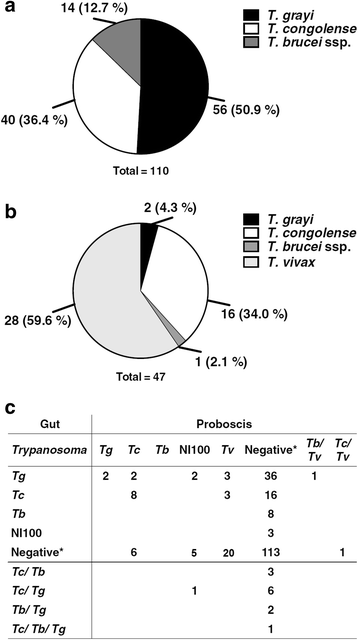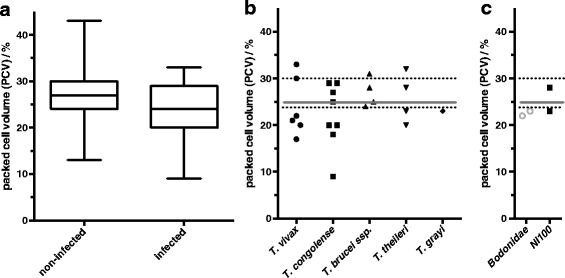Molecular screening of tsetse flies and cattle reveal different Trypanosoma species including T. grayi and T. theileri in northern Cameroon
- PMID: 29287598
- PMCID: PMC5747950
- DOI: 10.1186/s13071-017-2540-7
Molecular screening of tsetse flies and cattle reveal different Trypanosoma species including T. grayi and T. theileri in northern Cameroon
Abstract
Background: African trypanosomes are mainly transmitted through the bite of tsetse flies (Glossina spp.). The present study investigated the occurrence of pathogenic trypanosomes in tsetse flies and cattle in tsetse fly-infested areas of Northern Cameroon.
Results: Trypanosomes were identified using nested polymerase chain reaction (PCR) analysis of internal transcribed spacer 1 (ITS1) region, both by size estimation and sequencing of PCR products. Apparent density indices recorded in Gamba and Dodeo were 3.1 and 3.6 tsetse flies per trap and day, respectively. Trypanosoma prevalence infection rate for the tsetse fly gut (40%) and proboscis (19%) were recorded. Among the flies where trypanosomes were detected in the gut, 41.7% were positive for T. congolense and 14.6% for T. brucei ssp., whereas in the proboscis 36% harboured T. congolense and 62% contained T. vivax. T. grayi was highly prevalent in tsetse fly gut (58%). The most common mixed infections were the combination of T. congolense and T. grayi. Trypanosome prevalence rate in cattle blood was 6%. Among these, T. vivax represented 26%, T. congolense 35%, T. brucei ssp. 17% and T. theileri 17% of the infections. Surprisingly, in one case T. grayi was found in cattle. The mean packed cell volume (PCV) of cattle positive for trypanosomes was significantly lower (24.1 ± 5.6%; P < 0.05) than that of cattle in which trypanosomes were not detected (27.1 ± 4.9%). Interestingly, the occurrence of T. theileri or T. grayi DNA in cattle also correlated with low PCV at pathological levels.
Conclusion: This molecular epidemiological study of Trypanosoma species in Northern Cameroon revealed active foci of trypanosomes in Dodeo and Gamba. These findings are relevant in assessing the status of trypanosomosis in these regions and will serve as a guide for setting the priorities of the government in the control of the disease.
Keywords: Bodonidae; Cattle; ITS1; Northern Cameroon; Trypanosoma grayi; Trypanosoma theileri; Trypanosomosis; Tsetse fly.
Conflict of interest statement
Ethics approval
The study was conducted with the approval of the Ministère de l’élévage des pêches et des industries animales (MINEPIA) and by Mission spéciale d’éradication des glossines (MSEG) at the National and district levels, as well as the district veterinary officers in each of the study districts.
Consent for publication
Not applicable.
Competing interests
The authors declare that they have no competing interests.
Publisher’s Note
Springer Nature remains neutral with regard to jurisdictional claims in published maps and institutional affiliations.
Figures






Similar articles
-
Widespread co-endemicity of Trypanosoma species infecting cattle in the Sudano-Sahelian and Guinea Savannah zones of Cameroon.BMC Vet Res. 2019 Oct 16;15(1):344. doi: 10.1186/s12917-019-2111-6. BMC Vet Res. 2019. PMID: 31619238 Free PMC article.
-
Molecular epidemiological studies on animal trypanosomiases in Ghana.Parasit Vectors. 2012 Oct 1;5:217. doi: 10.1186/1756-3305-5-217. Parasit Vectors. 2012. PMID: 23025330 Free PMC article.
-
Molecular prevalence of trypanosome infections in cattle and tsetse flies in the Maasai Steppe, northern Tanzania.Parasit Vectors. 2017 Oct 23;10(1):507. doi: 10.1186/s13071-017-2411-2. Parasit Vectors. 2017. PMID: 29061160 Free PMC article.
-
Trypanosoma congolense: Molecular Toolkit and Resources for Studying a Major Livestock Pathogen and Model Trypanosome.Adv Parasitol. 2017;98:283-309. doi: 10.1016/bs.apar.2017.03.002. Epub 2017 May 5. Adv Parasitol. 2017. PMID: 28942771 Review.
-
Through the dark continent: African trypanosome development in the tsetse fly.Front Cell Infect Microbiol. 2013 Sep 18;3:53. doi: 10.3389/fcimb.2013.00053. eCollection 2013. Front Cell Infect Microbiol. 2013. PMID: 24066283 Free PMC article. Review.
Cited by
-
Molecular Identification of Trypanosome Diversity in Domestic Animals Reveals the Presence of Trypanosoma brucei gambiense in Historical Foci of Human African Trypanosomiasis in Gabon.Pathogens. 2022 Aug 30;11(9):992. doi: 10.3390/pathogens11090992. Pathogens. 2022. PMID: 36145424 Free PMC article.
-
Molecular and phylogenetic analysis of a type K1 strain Trypanosoma evansi isolate from Nigerian cattle: An evaluation of the therapeutic effects of compounds from Brassica oleracea on the histopathology of infected wister rats.Biochem Biophys Rep. 2023 Jan 10;33:101424. doi: 10.1016/j.bbrep.2023.101424. eCollection 2023 Mar. Biochem Biophys Rep. 2023. PMID: 36660764 Free PMC article.
-
Trypanosomes of the Trypanosoma theileri Group: Phylogeny and New Potential Vectors.Microorganisms. 2022 Jan 26;10(2):294. doi: 10.3390/microorganisms10020294. Microorganisms. 2022. PMID: 35208749 Free PMC article.
-
Diversity of tsetse flies and trypanosome species circulating in the area of Lake Iro in southeastern Chad.Parasit Vectors. 2021 Jun 2;14(1):293. doi: 10.1186/s13071-021-04782-7. Parasit Vectors. 2021. PMID: 34078431 Free PMC article.
-
Widespread co-endemicity of Trypanosoma species infecting cattle in the Sudano-Sahelian and Guinea Savannah zones of Cameroon.BMC Vet Res. 2019 Oct 16;15(1):344. doi: 10.1186/s12917-019-2111-6. BMC Vet Res. 2019. PMID: 31619238 Free PMC article.
References
Publication types
MeSH terms
Substances
Grants and funding
LinkOut - more resources
Full Text Sources
Other Literature Sources
Molecular Biology Databases
Miscellaneous

